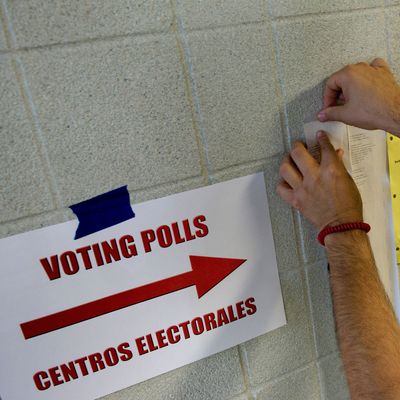
On Saturday, Connecticut’s General Assembly approved a bill that would make the state the 11th to adopt the National Popular Vote Interstate Compact, and the first since the 2016 election. Once enough other states have signed on, the bill would bind a state’s Electoral College votes — seven, in Connecticut’s case — to the candidate who wins the most raw votes in a presidential election. Governor Dannel Malloy is expected to sign it into law.
It’s another small step on the way to what advocates hope will turn into major election reform.
The Electoral College is one of the very worst features of American democracy, a vestigial mechanism that effectively reduces presidential contests to a few swing states. Like so much of our political system, it bestows disproportionate power to rural America. And, also like so much of our political system, it has taken on a deeply partisan cast. Democrats, increasingly clustered together in cities, have particular reason to loathe the Electoral College of late: it has helped crown two popular-vote losers, George W. Bush and Donald Trump, in the 21st century. Republicans, losers of six of the last seven popular votes, are more than happy to keep things as they are.
For years, Democratic efforts to reform this manifestly undemocratic set of rules amounted to little more than grumbles. Killing the Electoral College by conventional means would involve passing a nationwide constitutional amendment or convening a Constitutional convention, both close to impossible tasks. So clever reformists came up with an alternate route: passing state laws that would take effect only when it is guaranteed that enough other states have signed on to swing the outcome. The magic number is 270 electoral votes, out of the 538 available.
In 2007, Maryland became the first state to join the compact. The other states that have signed on over the last 11 years are all reliably blue: California, Hawaii, Illinois, Massachusetts, New Jersey, New York, Rhode Island, Vermont, and Washington state. Washington, D.C., is also onboard.
Together, these states account for 172 electoral votes, just 98 short of hitting their goal. But most of the remaining states in the union are either deep-red, and thus unlikely to favor a solution that stands to benefit Democrats, or swing states, and thus unlikely to favor a solution that would divert the campaign spotlight from their neck of the woods every four years.
This is where the 2018 elections come in. If Democrats can make progress in winning back some of the governorships and state legislatures they’ve forfeited over the years, they’ll be in much better shape to push through the popular-vote legislation in a few more states, making what once seemed like a pipe dream tantalizingly close to reality. (One caveat: Even if cooperating states do hit their target, it’s unclear whether the federal government would need to give them its blessing.)
Opponents of the provision argue that nullifying the Electoral College wouldn’t solve the problem of candidates focusing too much on one area of the country.
“If you switch to national popular vote and I’m a candidate for president and I’m a Democrat, I’m going to plant my team in California, the upper Midwest, New York City and Philadelphia,” Connecticut State Senator Michael McLachlan said, in a representative argument.
But it’s unlikely that the new arrangement would be more unfair than the one we have now. As Vox’s Andrew Prokop argued in 2016, “a national popular vote system wouldn’t devalue the votes of people who live in rural states and small towns. It would accurately value them by treating them equal to people who live in cities, rather than giving them an extra weighting.”
In terms of pure fairness, this is certainly a change worth fighting for. It’s going to be a heavy lift, but after 230 years, we may just be witnessing the last gasps of a dying, unfair tradition.






























